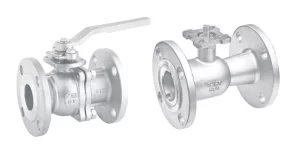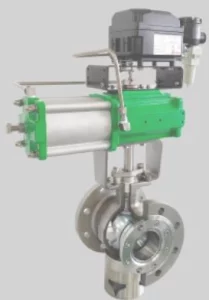How to Choose the Right Stainless Ball Valve for Your Needs
Exploring the Basics of Stainless Ball Valves
Definition and Functionality of Stainless Ball Valves
Stainless steel ball valves are reliable industrial components that control the flows of acids and other materials in both saturated steam systems & condensed flow systems. These valves work with the help of a hollow, perforated, and rotating ball that controls the flow that goes through it. If the hole in the ball is lined up along with the flow path, then this valve is open, if it faces out from that flow path, then it is closed. This is a very simple mechanism for quick shut-off and control.
Key Components of a Stainless Ball Valve
|
Component |
Description |
|
Ball |
The central component that controls the flow by rotating within the valve body. It features a bore through which fluid passes when aligned with the pipeline. |
|
Stem |
Connects the ball to the external actuator or handle, enabling rotation and control of the ball’s position. |
|
Seats |
Provide sealing between the ball and body, ensuring leak-proof operation. They are typically made from materials like PTFE or PEEK for durability and chemical resistance. |
|
Body |
Encases all internal components, providing structural integrity and protection against external elements. Typically constructed from stainless steel for corrosion resistance and strength. |
Benefits of Using Stainless Steel Material
Stainless steel is the right ball valve material for many reasons; great resistance to corrosion, temperature, and pressure sustainability. It provides a long-lasting, reliable service in extreme environments and is perfect for applications such as chemical processing and water treatment. That ruggedness makes it perfect for long-term reliability in tough environments, including applications from chemical processing to water treatment.
Identifying Your Specific Requirements
Understanding Different Applications for Stainless Ball Valves
Stainless ball valves are suitable for a plethora of industries like oil and gas, pharmaceuticals, food processing, and others. Any application has a special need for valve design, material compatibilities, and operational conditions. The particulars around valve design, material compatibility, and operational conditions can differ from one application to the next.
Determining Pressure and Temperature Ratings
An example is that if you would like to choose the stainless ball valve, you need to have a good understanding of its pressure and temperature. Valves are pressure class rated ( Class 150 or Class 300) and temperature range rated so they will work properly without failure.
Considering Flow Control Needs
Flow control requirements will determine if you choose a full port or reduced port design. They are designed for all applications where you need the highest flow capabilities with minimal valve flow restriction. Reduced port valves offer less control of the velocity of a fluid but they may create some pressure drop. Full port valves offer more control over the fluid velocity but can cause a small amount of pressure drop.
Types of Stainless Ball Valves and Their Features
Floating vs. Trunnion Mounted Ball Valves
A floating ball valve features a free-floating ball in which the ball is held tight against the downstream seat by line pressure that seals it. These are ideal for applications under low to medium pressure. Trunnion mounted ball valves have mechanical anchors at both ends of the ball to protect from wear due to high pressure acting on the valve seat.
Full Port vs. Reduced Port Designs
Full port (or full bore) designs provide no restriction through the valve and are equal to pipe diameter size, so the pressure drop across the valve is minimized. Reduced port (or standard bore) designs have a smaller bore than pipe diameter size, which can cause minor flow restrictions but are good for more compact valve sizes.
Two-Way vs. Multi-Port Configurations
Two-way stainless ball valves comprise a popular design that enables fluids to either flow straight through it or, be completely switched off. Three-port or four-port configurations allow for complex flow paths to occur through a system without having multiple separate valves, which is perfect if you need an efficient way to divert or mix flows.
When selecting a stainless ball valve for your specific needs, consider these factors carefully to ensure optimal performance in your application environment.
Factors to Consider When Selecting a Stainless Ball Valve
Corrosion Resistance and Material Compatibility
Corrosion resistance and compatibility with materials of construction should be given high priority when selecting a stainless ball valve for media to be handled. Stainless steel has a well-deserved reputation for corrosion resistance, and it’s often used in extreme environments subjected to harsh chemicals or high heat perforations. However, there are many different types of stainless steel. As an example, 304 stainless steel is a great material for various applications but where resistance to chlorides and acid is critical in more corrosive service environments, 316 stainless will provide a greater level of protection. The valve materials need to have a high affinity with the chemical contents of process fluid; understanding these specific interactions ensures durability and performance longevity.
End Connection Types and Their Implications
End connection types are another key factor in stainless ball valve selection. Common types of connection thread, flange, and butt weld Threaded – Role threaded joints are more often employed on smaller diameter piping systems, and have the benefit of easy installation and maintenance. For larger pipelines or systems that need to be broken down frequently for maintenance, flanged connections can provide a robust and easily disassembled solution. Welded ends offer a permanent connection without the possibility of leaks in the joints, but require more accurate installation processes. The end connection selection should be based on the pressure requirement, accessibility for maintenance, and any future system changes.
Maintenance and Longevity Considerations
Choosing a stainless ball valve is an important decision based on maintenance requirements and the lifetime of valves. Live-loaded stem seals that self-adjust packing to compensate for wear and temperature-related changes in seal efficiency can reduce maintenance intervals. And, replaceable seats and seals also serve to prolong valve life in that worn components can be replaced without discarding the entire valve. Factors such as planned operational lifespan and frequency of maintenance are key to selecting a valve that provides maximum uptime and efficiency in operation.
Making an Informed Decision with Miwival Products
Advantages of Choosing Miwival for Your Valve Needs
Miwival is known for quality engineering, innovation, and all the advantages justified when it comes to the selection of Miwival manufactured stainless ball valves. These products are designed to meet rigorous industry standards, and they provide reliability in a range of applications. Pressure-energized stem packing that is able to minimize the chances of leakage even in high-pressure surroundings, is a few advanced sealing technologies you can find in Miwival’s valves. Also, their anti-static devices are designed to prevent electrical discharge in the valve and provide safe operation.
Overview of Miwival’s V Port Segmented Ball Valve
The V Port Segmented Ball Valve by Miwival is one of the best illustrations showcasing their excellence in flow control solutions. This kind of valve is best fitted for high-precision flow regulation under a broad range of form conditions. The customizable V-port design allows for exact throttling capability, even at low flow rates, allowing precision control wherever it is needed most in the field at industries such as pulp processing.
The V Port Segmented Ball Valve is built with top and bottom bearings to minimize operating torque allowing the use of smaller actuators without sacrificing performance. With its one-piece leak-proof body, it is designed for a reliable seal avoiding possible leakage points. Fewer potential points of leakage are no match for its leak-proof, one-body design to keep everything sealed.
In summary, the determination of stainless ball valves paid attention to materials selection, type of connection needed, maintenance demand, and application by nature. Choosing Miwival products like their V Port Segmented Ball Valve gives you designs not only of higher control capabilities but are also designed for the solution your industry needs.







